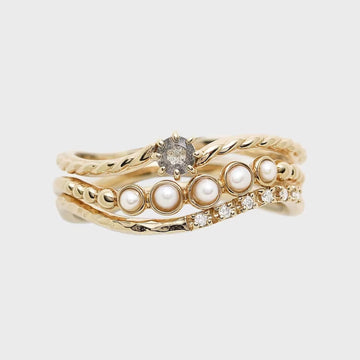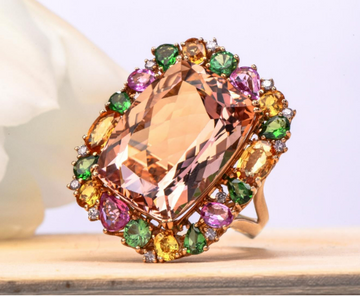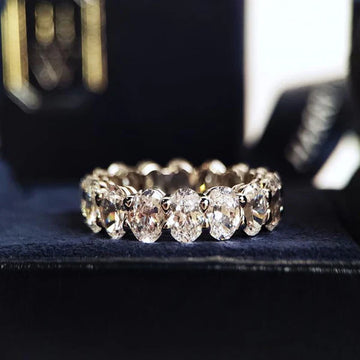When shopping for pearls, whether online or in person, it can sometimes be tricky to differentiate between real and fake pearls. With the rise of synthetic materials and high-quality imitations, the market is full of both genuine and counterfeit options. The allure of pearls has been timeless—symbols of luxury, sophistication, and elegance. However, without proper knowledge, you might end up purchasing imitation pearls, which are often far cheaper and not as durable or valuable as real pearls.
In this comprehensive guide, we'll teach you how to spot fake pearls by examining their key characteristics—such as surface texture, luster, weight, and more. Armed with this knowledge, you'll be able to confidently tell the difference between authentic pearls and imitations, ensuring you make an informed purchase that reflects the true value of the piece.
A:Understanding the Types of Pearls
Before diving into the methods of identifying real pearls, it's important to understand that pearls come in different types and qualities. Real pearls can be divided into two main categories: natural pearls and cultured pearls. Both types are genuine pearls, though cultured pearls are farmed with human intervention, while natural pearls form spontaneously in the wild.
Additionally, pearls can be further classified based on their origins:
- Saltwater Pearls: These include varieties like Akoya, Tahitian, and South Sea pearls, and are typically more expensive due to their rarity and unique characteristics.
- Freshwater Pearls: These are often more affordable and come in a variety of shapes and sizes, ranging from round to irregular baroque forms.
While genuine pearls are prized for their natural beauty, many counterfeit pearls are now available in the market, mimicking the look of real pearls but with significant differences in texture, composition, and overall appearance.
B:The Surface Texture
The surface texture is one of the most telling signs when differentiating between real and fake pearls. Authentic pearls are formed through natural processes inside mollusks, meaning they have a distinct surface texture that cannot be replicated by synthetic materials.
-
Real Pearls: A genuine pearl typically has a slightly uneven surface, with natural blemishes or irregularities such as small ridges, dimples, or grooves. These imperfections occur as the mollusk secretes layers of nacre around the irritant over time. The more layers of nacre a pearl has, the smoother its surface will appear, but there will almost always be slight variations.
-
Fake Pearls: Imitation pearls, on the other hand, are often perfectly round and smooth with little to no imperfections. This smoothness can be a giveaway that a pearl is synthetic. A common type of fake pearl is made from plastic or glass, which is coated with a shiny, pearlescent layer. If you inspect the surface closely, you may notice that the coating is uniform and artificial-looking, lacking the organic quality found in real pearls.
Tip: Gently rub a pearl against your teeth or the edge of your tongue. Real pearls have a slightly gritty texture, due to their natural nacre layers, while fake pearls made of plastic or glass will feel smooth and slippery.
C: Luster and Shine:
One of the key characteristics of real pearls is their unique luster—the way they reflect light. Authentic pearls have a deep, rich shine that emanates from within, often described as "luminous" or "pearlescent." The luster of a real pearl depends on the quality of its nacre, which is the substance secreted by the mollusk that coats the pearl. The thicker the nacre, the better the luster.
-
Real Pearls: A genuine pearl will have a subtle, soft glow, as light is reflected off the layers of nacre inside the pearl. High-quality pearls, such as Akoya pearls, have a mirror-like shine, while other pearls like Tahitian or South Sea pearls may have a more subdued, matte glow. However, in all cases, the luster is rich and multi-dimensional, varying slightly with different angles of light.
-
Fake Pearls: Imitation pearls often have a superficial shine that can appear overly glossy, artificial, or one-dimensional. Fake pearls may shine brightly in direct light but lack the depth and complexity of real pearls. Additionally, they can sometimes look "plasticky" or "glassy," a clear indicator that they are not genuine.
Tip: Look at the pearl from different angles. Real pearls tend to shimmer and reflect light in a more complex, nuanced way, while fake pearls might look more flat or unremarkable in comparison.
D:Weight and Density
Real pearls are denser and heavier than synthetic pearls, which are often made from lighter materials such as plastic or glass. This difference in weight can be a useful clue when trying to determine the authenticity of a pearl.
-
Real Pearls: Due to the natural composition of a genuine pearl, which consists of layers of nacre and organic material, real pearls feel heavier and more substantial. The weight of a pearl should feel appropriate to its size—larger pearls will naturally weigh more.
-
Fake Pearls: Imitation pearls, especially those made from plastic, are much lighter. If the pearl feels unusually light or too light for its size, it’s likely an imitation. You can also compare the weight of the pearl to other genuine pearls you may own or see in a jewelry store for a reference.
Tip: Compare the weight of the pearl in question with that of a known genuine pearl. Real pearls will always feel more substantial.
E:Temperature of the Pearl
Another way to test a pearl’s authenticity is by checking its temperature. Real pearls, due to their natural composition, take on the temperature of their environment more slowly.
-
Real Pearls: When you hold a real pearl in your hand, it will feel cool to the touch at first but gradually warm up to your body temperature. This gradual warmth is due to the organic material within the pearl, which doesn’t heat up quickly.
-
Fake Pearls: On the other hand, synthetic pearls, especially those made from plastic or glass, often feel warmer to the touch immediately. This is because these materials retain heat more quickly and don't have the same organic properties as real pearls.
Tip: Hold the pearl in your hand for a few seconds and observe how quickly it warms up. If it becomes warm right away, it’s likely fake.
F:The Nacre Test
Nacre, also known as mother-of-pearl, is the material that forms the layers around a real pearl. The thickness of the nacre plays a significant role in the pearl's overall quality, luster, and durability. Imitation pearls do not have this complex nacre structure and may only have a superficial coating over a plastic or glass core.
-
Real Pearls: If you cut a genuine pearl in half (which is not recommended unless necessary), you would see the nacre layers, which are thick and layered. The core of a real pearl is often made of organic material, and the nacre layers are built up over time by the mollusk.
-
Fake Pearls: Fake pearls often have a thin, artificial coating of nacre-like material, but it lacks the depth and complexity of natural nacre. If you look closely at a fake pearl, you may notice that the coating is thinner or unevenly applied.
G:Professional Certification and Appraisal
If you are unsure about the authenticity of a pearl, the best approach is to consult a professional jeweler or gemologist. Reputable jewelers can provide a certificate of authenticity, which verifies whether the pearl is natural, cultured, or synthetic. This is especially important when purchasing high-value pearls or pearls for investment purposes.
Conclusion: Why It’s Important to Know How to Spot Fake Pearls?
Being able to identify real pearls ensures that you’re investing in high-quality, durable jewelry. Fake pearls may seem like a good deal at first, but they won’t have the same lasting beauty, luster, and value as genuine pearls. By learning the key differences—surface texture, luster, weight, temperature, and more—you can confidently distinguish real pearls from their counterfeit counterparts.
Whether you're buying a pearl necklace, earrings, or other jewelry, these tips will help you spot fake pearls and ensure that you’re getting the genuine article. Always remember that the value of pearls goes beyond their appearance; it’s the natural process and organic composition that make them truly special. So next time you're in the market for pearls, use these tips to make sure you’re buying the best.








